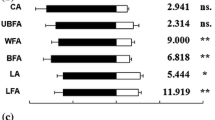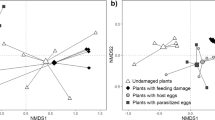Abstract
Oviposition responses of gravid Conogethes punctiferalis (Guenée) females to various parts of 4 host and 14 non-host plants were assessed in laboratory cage tests, where females were not allowed to contact the materials tested. Normal responses were observed to typical host plants. Unexpectedly, the females showed normal oviposition responses to 13 species of non-host plant parts, even though some were underground parts. On the other hand, no or slight responses were observed to potato tubers and leaves. In choice tests between different parts of the same host plant, females always preferred young fruits. Females preferred young peach fruits to turnip taproots, but no preference was seen between codling and turnip, and they unexpectedly preferred Brussels sprout buds to codlings. However, when females were allowed to contact plant materials, they laid few eggs on the host and non-host leaves that attracted them in the olfaction stimulus assays. Egg distributions on codling and chestnut were concentrated at the stem cavity or calyx end and spiny involucre, respectively. These results indicate not only that oviposition was induced by plant olfactory stimuli, but also that various non-host plants potentially stimulate oviposition. Even in host plants, biophysical stimuli also restrict oviposition, suggesting that the real host range for oviposition may be narrower than that expected from laboratory assessments based on olfactory responses of female moths.
Similar content being viewed by others
References
Anfora G, Tasin M, De Cristofaro A, Ioriatti C, Lucchi A (2009) Synthetic grape volatiles attract mated Lobesia botrana females in laboratory and field bioassays. J Chem Ecol 35:1054–1062
Anonymous (2006) Major insect and other pests of economic plants in Japan, revised edn. Japanese Society of Applied Entomology and Zoology, Tokyo, pp 126–129, 354 (in Japanese)
Baur R, Haribal M, Renwick JAA, Stadler E (1998) Contact chemoreception related to host selection and oviposition behaviour in the monarch butterfly, Danaus plexippus. Physiol Entomol 23:7–19
Bengtsson M, Jaastad G, Knudsen G, Kobro S, Bäckman AC, Pettersson E, Witzgall P (2006) Plant volatiles mediate attraction to host and non-host plant in apple fruit moth, Argyresthia conjugella. Entomol Exp Appl 118:77–85
Bernays EA, Chapman RF (1994) Odor-induced attraction. In: Host plant selection by phytophagous insects. Chapman and Hall, New York, pp 97–107
Brévault T, Quilici S (2009) Oviposition preference in the oligophagous tomato fruit fly, Neoceratitis cyanescens. Entomol Exp Appl 133:165–173
Brévault T, Quilici S (2010) Interaction between visual and olfactory cues during host finding in the tomato fruit fly Neoceratitis cyanescens. J Chem Ecol 36:249–259
Calatayud PA, Ahuya PO, Wanjoya A, Le Rü B, Silvain JF, Frérot B (2008a) Importance of plant physical cues in host acceptance for oviposition by Busseola fusca. Entomol Exp Appl 126:233–243
Calatayud PA, Guénégo H, Ahuya P, Wanjoya A, Le Rü B, Silvain JF, Frérot B (2008b) Flight and oviposition behaviour of the African stem borer, Busseola fusca, on various host plant species. Entomol Exp Appl 129:348–355
Foster S, Howard A, Harris M (1997) The influence of tactile and other non-chemical factors on the ovipositional responses of the generalist herbivore Epiphyas postvittana. Entomol Exp Appl 83:147–159
Galanihe LD, Harris MO (1997) Plant volatiles mediate host-finding behavior of the apple leafcurling midge. J Chem Ecol 23:2639–2655
Goyret J, Markwell PM, Raguso RA (2007) The effect of decoupling olfactory and visual stimuli on the foraging behavior of Manduca sexta. J Exp Biol 210:1398–1405
Gupta PD, Thorsteinson AJ (1960) Food plant relationships of the diamond-back moth (Plutella maculipennis). II. Sensory regulation of oviposition of the adult female. Entomol Exp Appl 3:241–250
Heinz CA (2008) Host plant odor extracts with strong effects on oviposition behavior in Papilio polyxenes. Entomol Exp Appl 128:265–273
Honda H, Matsumoto Y (1984) Oviposition responses of the fruit-feeding type of yellow peach moth, Conogethes punctiferalis Guenée (Lepidoptera: Pyralidae). Jpn J Appl Entomol Zool 28:82–86 (in Japanese with English summary)
Honda H, Kaneko J, Konno Y, Matsumoto Y (1979) A simple method for mass-rearing of the yellow peach moth, Dichocrosis punctiferalis Guenée (Lepidoptera: Pyralidae), on an artificial diet. Appl Entomol Zool 14:464–468
Inoue H, Yamanaka H (2006) Redescription of Conogethes punctiferalis (Guenée) and descriptions of two new closely allied species from eastern Palaearctic and oriental regions (Pyralidae, Pyraustinae). Tinea 19:80–91
Jeffries MJ, Lawton JH (1984) Enemy free space and the structure of ecological communities. Biol J Linnean Soc 23:269–286
Kaneko J (1978) Abdominal constriction in the copulated female of yellow peach moth, Dichocrosis punctiferalis Guenée (Lepidoptera: Pyralidae). Appl Entomol Zool 13:131–133
Kimura T (2002) Chemical ecology of sex pheromones in Conogethes sibling species. Doctoral dissertation. University of Tsukuba, Tsukuba (in Japanese)
Kondo A, Nagata K, Mochizuki F (2008) Geographical differences in pheromone trap performance in the yellow peach moth, Conogethes punctiferalis (Guenée) (Lepidoptera: Pyralidae) occurring in Japanese peach orchards. Jpn J Appl Entomol Zool Chugoku Branch 50:35–38 (in Japanese with English summary)
Konno Y, Arai K, Sekiguchi K, Matsumoto Y (1982) (E)-10-hexadecenal, a sex pheromone component of the yellow peach moth, Dichocrocis punctiferalis Guenée (Lepidoptera: Pyralidae. Appl Entomol Zool 17:207–217
Lakshminarayana M (2005) Studies on antixenosis in castor, Ricinus communis L., against major insect pests. Indian J Plant Prot 32:216–219
Linn C, Nojima S, Roelofs W (2005) Antagonist effects of non-host fruit volatiles on discrimination of host fruit by Rhagoletis flies infesting apple (Malus pumila), hawthorn (Crataegus spp.), and flowering dogwood (Cornus florida). Entomol Exp Appl 114:97–105
Masante-Roca I, Anton S, Delbac L, Dufour MC, Gadenne C (2007) Attraction of the grapevine moth to host and non-host plant parts in the wind tunnel: effects of plant phenology, sex, and mating status. Entomol Exp Appl 122:239–245
Myers CT, Hull LA, Krawczyk G (2006) Seasonal and cultivar-associated variation in oviposition preference of Oriental fruit moth (Lepidoptera: Tortricidae) adults and feeding behavior of neonate larvae in apples. J Econ Entomol 99:349–358
Nava D, Parra J, Diez-Rodríguez G, Bento J (2005) Oviposition behavior of Stenoma catenifer (Lepidoptera: Elachistidae): chemical and physical stimuli and diet pattern of egg laying. Ann Entomol Soc Am 98:409–414
Plepys D, Ibarra F, Francke W, Löfstedt C (2002) Odour-mediated nectar foraging in the silver Y moth, Autographa gamma (Lepidoptera: Noctuidae): behavioural and electrophysiological responses to floral volatiles. Oikos 99:75–82
Pontes WJT, Lima ER, Cunha EG, De Andrade PMT, Lôbo AP, Barros R (2010) Physical and chemical cues affect oviposition by Neoleucinodes elegantalis. Physiol Entomol 35:134–139
Proffit M, Birgersson G, Bengtsson M, Reis R Jr, Witzgall P, Lima E (2011) Attraction and oviposition of Tuta absoluta females in response to tomato leaf volatiles. J Chem Ecol 37:565–574
R Development Core Team (2010) R: a language and environment for statistical computing. R Foundation for Statistical Computing, Vienna. http://www.r-project.org/
Ramaswamy SB (1988) Host finding by moths: sensory modalities and behaviours. J Insect Physiol 34:235–249
Renwick JAA, Chew FS (1994) Oviposition behavior in Lepidoptera. Annu Rev Entomol 39:377–400
Rojas J, Virgen A, Cruz-Lópezb L (2003) Chemical and tactile cues influencing oviposition of a generalist moth, Spodoptera frugiperda (Lepidoptera: Noctuidae). Environ Entomol 32:1386–1392
Schoonhoven LM, van Loon JJA, Dicke M (2005) Olfactory specificity and coding, physical plant features acting during contact. In: Insect-plant biology, 2nd edn. Oxford University Press, Oxford, pp 157–158, 170–172
Sekiguchi K (1974) Morphology, biology and control of the yellow peach moth, Dichocrosis punctiferalis Guenée (Lepidoptera: Pyralidae). Bull Ibaraki Hort Expt Stn Special Issue:2–6 (in Japanese with English summary)
Shinkaji N (1969) Studies on the peach pyralid moth, Dichocrocis punctiferalis GUENÉE (Lepidoptera: Pyralidae). I. Seasonal development with special reference to the difference between the fruit tree type and conifer type. Bull Hort Res Stn Jpn Ser A 8:155–208 (in Japanese with English summary)
Späthe A, Reinecke A, Olsson SB, Kesavan S, Knaden M, Hansson BS (2013) Plant species- and status-specific odorant blends guide oviposition choice in the moth Manduca sexta. Chem Senses 38:147–159
Tasin M, Bäckman AC, Bengtsson M, Ioriatti C, Witzgall P (2006) Essential host plant cues in the grapevine moth. Naturwissenschaften 93:141–144
Tasin M, Lucchi A, Ioriatti C, Mraihi M, De Cristofaro A, Boger Z, Anfora G (2011) Oviposition response of the moth Lobesia botrana to sensory cues from a host plant. Chem Senses 36:633–639
Tingle FC, Mitchell ER (1991) Effect of oviposition deterrents from elderberry on behavioral responses by Heliothis virescens to host-plant volatiles in flight tunnel. J Chem Ecol 17:1621–1631
Visser JH (1986) Host odor perception in phytophagous insects. Ann Rev Entomol 31:121–144
Waterhouse DF (1993) The major arthropod pests and weeds of agriculture in southeast Asia: distribution, importance and origin. ACIAR Monogr No. 21. ACIAR, Camberra, pp 40–44, 49–52, 81–125
Xiao W, Matsuyama S, Ando T, Millar JG, Honda H (2012) Unsaturated cuticular hydrocarbons synergize responses to sex attractant pheromone in the yellow peach moth, Conogethes punctiferalis. J Chem Ecol 38:1143–1150
Acknowledgments
We thank Prof. Ryo Ohsawa, Prof. Junko Sugaya, and Dr. Kiyokazu Kawada for their advice on statistics, botanical morphology, and identification, respectively, and Prof. DeMar Taylor for his critical reading and comments on the manuscript. We are also grateful to Mr. Rikio Satoh for supplying codlings.
Author information
Authors and Affiliations
Corresponding author
Rights and permissions
About this article
Cite this article
Luo, Z., Honda, H. Olfactory and biophysical assessment of the oviposition stimulating potential of host and non-host plants for the yellow peach moth, Conogethes punctiferalis (Lepidoptera: Crambidae). Appl Entomol Zool 50, 183–189 (2015). https://doi.org/10.1007/s13355-014-0320-9
Received:
Accepted:
Published:
Issue Date:
DOI: https://doi.org/10.1007/s13355-014-0320-9




